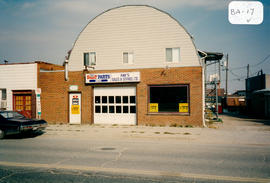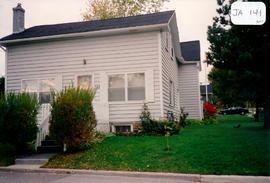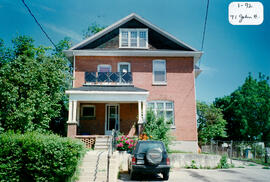The mid-block building located at 89 John St. East is set well back from street. It was built around 1860-1880’s in the Ontario Vernacular Cottage style. John Edwin (or Harry) Cerswell, a retired gentleman, lived here at one time before selling the house. Dave Mundy and Walter moved here from their farm on the 10th line. Dave worked for Holland River Gardens and Walter worked for the Spence Lumber Co. Walter built a garage at the back of the house. When Dave died the house was sold. Years later, a small house was built along the back fence to provide housing for marsh workers. Joe McMillan and his daughter rented it, as did Dick Roberts and Wilma. Lorne Campbell and his wife also lived here after World War II. It was later demolished.
The one-storey, three-bay cottage seen in this photo from 1995 has a rectangular plan with a centre hall. A box hall was typical for this style. It also has a symmetrical façade and a shallow-pitched, gable roof. There is a simple entrance with a single door set into a rectangular opening. It opens directly into the house from slightly above grade level. No porch or weather protection shelters the entrance. The house has small windows with low floor to ceiling heights. There are double-hung windows on either side of the entrance. The 2/2 windows appear to be original. Windows are set into simple, rectangular openings with plain, wood frames and sills. The building has wood frame construction, vinyl siding, a stone-rubble foundation, and a basement with window openings. Originally, the siding was wood. A one-storey addition at the side of house is not original and it has different foundation material. According to the 2000 inventory, this simple cottage probably had few decorative details originally. It notes that other than the building’s form, few existing building elements appear to be original. (1, 2, 3)
Rental
12 Descrição arquivística resultados para Rental
The mid-block building located on the north side at 101 John St. East was built pre-1900 in the Gothic Revival Cottage style. Originally, there was a woodshed across the back. It was the home of Mrs. Leduc or Mrs. Paul Courier, a French descendant from the old lumber mills. She wove rugs and blankets and repaired clothing. After her death the house was rented. Howard Robson and his wife lived here with part of their family, namely, Alvin, Garret and Phyllis. The building then became the home of Henry Pringle and his wife Joan. He was a retired railroad section man and owner of a garage on Holland Street. It was still the home of Joan Pringle when this photo was taken in 1995.
The 1½-storey, three-bay house has a rectangular plan, a centre hall, and a symmetrical façade.
Its medium-pitched, gable roof has a centre gable over the entrance. The building has small windows with low floor to ceiling heights. There are double-hung windows in rectangular openings with plain, wood frames and sills. The entrance porch, its windows, screen door, and the metal awnings are not original. A brick chimney at the exterior wall is also a recent reconstruction. The building has wood frame construction, vinyl siding and a parged stone foundation. Originally, the cladding was stucco. According to the 2000 inventory, the building’s basic form is camouflaged by the later additions. (1, 2, 3)
Alex Sutherland’s bakeshop was located at 27 Simcoe Road for many years. It was later sold to Howard Bowser. Howard converted it into a rental dwelling. The building was eventually owned by a market gardener who had a cement garage and storage building constructed by Len Saint on the property. Neil Lathangue and his wife lived here for a time years later. After they left, Tommy and Bill Whiteside moved in and remained here until they died. (1, 2)
Sem títuloThe Dr. Clement House is located at 41 Simcoe Road (on the southeast corner of Simcoe Road and Centre Street). It was built around 1830-1860 (1840’s?) in the Classic Revival style. Dr. Clement lived and died here after practising in the 1870-80’s. He was buried in Clement Cemetery on the 2nd Line in Innisfil (east of Highway 11). His wife Rachel lived here until her death. The house was then rented to Walton, a railroad man for the C.N.R. The barn and garden behind the building ran to William St. (as did all the properties on the east side). Sam Catania and his wife Sarah lived here in later years. They converted the house into two apartments and had a dry cleaning business in the garage that was eventually destroyed by fire. Sam sold the house to Bruce and Barbara Verney. They were still living here when this photo was taken in 1995. Bruce was a chiropractor. A building used as a dry cleaner was constructed later on the property. Jack Pong (a restaurant owner on Holland St.) built a house on the back of this property that extended to Centre Street.
The street level has apparently been raised considerably around this house as the current 1½-storey, two-bay house was originally 2½ storeys. It has an asymmetrical façade and entrance, a simplified ‘temple’ form, and a medium-pitched, gable roof. The pediment roof shape has return eaves facing the front. A hip roof on the raised entrance portico is supported on wood beams with decorative, wood dentils. The corner columns have wooden ‘flutes’ and are mounted on brick pedestals. A wood-panelled door is flanked by narrow sidelights and is topped by a transom light. The house has small window openings with low floor to ceiling heights. Small, upper-floor windows are set into rectangular openings with plain, wood frames and sills. A ground-floor, bay window is an angled projection with a hip roof. The brick masonry foundation appears to be a replacement. A horizontal belt line at the top of the foundation is expressed with wood trim. The structure has wood frame construction with stucco cladding and a cut-stone foundation. Bricks found at the bay window foundation and at the entrance porch are probably not original. According to the 2000 inventory, the house is in good condition with many original details. (1, 2, 3, 4)
The structure located at 70 and 72 John St. East is a double, T-shaped, frame house once owned by Jim Spence (the former owner of the Spence Lumber Company). Jim and his children, Minnie (Hammel) and Alex, lived on the east side of the building (72 John St. East). His son eventually took over the lumber business. Jim rented the west side of the building (70 John St. East) to Harry Barron. In later years it became the home of Casey Stewart, his wife Annie (George Harman’s sister), and their daughter Velma. Casey worked for Jessie Sutherland before moving to Toronto. Ted Gore, an English World War I veteran, also lived here at one time with his family of two sons. (1, 2)
Sem títuloThis two-storey structure is located at 218 Simcoe Road. It is the fourth house on the west side (south of the “Y” in Simcoe Road). Robert Stewart, his wife, and family lived here many years ago. His son George, who married Ethel Waldruff, played lacrosse and was a painter and paper hanger for Billie Sutton. Robert owned 75 acres of land and worked as the town clerk for 25 years. He also farmed (and later rented) his land. Ed Cave and his wife (Ida) and daughter (Violet) moved to this area from Newton Robinson and eventually bought and worked a farm. He delivered milk and had a dairy in town. Ed was a staunch Orangeman who played King Billie riding his white horse at the 12th of July parade. There was a gravel pit on the property. He eventually sold his farm to Mike Sklencar, John Kulha, Steve Brinkos and John Kashmere. They divided the remaining land and sold the lots along Simcoe Road. The large house was converted into four apartments that were used as their living quarters while they each built a house. The structure was still being used as an apartment building in 1995. (1, 2)
Sem títuloThe cement brick building (with an arch) that is located at 17 Barrie St. is not the original structure at this site. Originally, there was a large frame building (used to shelter horses, a stage coach, buggies, cutters, etc.) that was part of a livery stable owned by Dave Ogilvie many years ago. It was destroyed by fire shortly after Dave bought it and the building seen in the photo is a smaller replacement. Dave also ran a stage coach line (later a taxi service) to Newmarket to meet the Metropolitan street car. Travelling salesmen would use this stage line to bring their wares and samples to town. They would stay at the Queen’s Hotel, where they would take orders from customers. They then used the stage coach and livery to go to Middletown, Bond Head, Newton Robinson, Beeton, Cookstown, Fennell’s Corner and then back home. Dave also hauled mail from the train station to the local post office, as well as to Bond Head. When automobiles replaced horses, the stables were removed from the building and people rented storage there for their vehicles. In time, Dave added a small office, toilets and gas pumps. After he died, Gordon and Mac ran the business until it was sold to Fred Gregory. Fred ran a car repair shop and employed a mechanic. Fred had a rental apartment built upstairs. It had outside stairs to the laneway. When Fred got sick he rented the building to Ray O’Neil who later bought it. Ray sold the building to the European Bakery in 1994. (1, 2)
Sem títuloThe Standard Bank is located at 65 and 67 Holland St. West. It was built in the Romanesque Revival style around 1860-1900. O.M. Seim, previous owner of the Bradford Witness newspaper (1916-1932), and his family (Gordon, Ken, Marjorie, Maurice and Betty) once lived here. Dr. McMichael, a dentist, lived on John St. but had his practice here many years ago. Aubrey Stewart (and her son Bruce) at one time had an Insurance company here and the living quarters were rented. The building was eventually converted into apartments.
The commercial building (67 Holland St. W.) is set close to the street. Originally, there was a large, walk-in vault at the rear of the building on the ground floor. Residential quarters were on the second floor. The two-storey building has tall window openings with high floor to ceiling heights and an asymmetrical façade with a simplified ‘temple’ form. There is a medium-pitched, ‘pediment’ gable roof facing the front and a tympanum with a rose window. Brick pilasters support a plain cornice and frieze at both the ground and second floors to create the image of a classical Greek temple (combined with the more Roman arch form). The commercial entrance is contained within one of the two corbelled arches and is raised slightly. A double-panelled door is topped by a multi-paned transom light. The ground floor bank window is set into a corbelled arch opening with a transom light and stone or concrete lug sills. Upper windows are set into rectangular openings with transom lights. The cornice and frieze at the ground and second floors are ‘supported’ on corbelled brick brackets. This building has brick masonry construction and a cut-stone foundation.
The residential wing (65 Holland St. West) is set further back from the street to provide greater privacy to the living quarters. It takes a more recessive form with an open verandah at the ground floor and an enclosed porch on the upper floor running the full width of the house. There is a hipped roof on the residential wing. The entrance door to the house also a transom light, but like the rest of the residential wing, it does not have the rich texture or detail found on the more public portion of the building. The residential porch posts, railing, door, and windows are not original. According to the 2000 inventory, the structure is in good condition with many original details remaining. (1, 2, 3)
Please contact the Bradford West Gwillimbury Public Library (905-775-3328) if you have any other information about this photo.
The building located at 141 James St. was once the home of Alex Spence. It was also rented by Peter Scroogal at one time. (1)
Sem títuloThe mid-block building located at 71 John St. East was built around 1900 in the Edwardian Classicism style. It was once the home of Sam Stein and his son and daughter. He was the owner of the Toronto Manufacturing Co. (maker of baby carriages and wicker furniture). His business was located on the northwest corner of Dissette St. until around 1929. After its end, the house was rented to a number of O.P.P. officers and their families, including Ivan Spence and Sam Irwin (a talented violin player). It was also the home of Joe Kanyo (a market gardener) and his family at one time. Leonard Saint built a large cement garage at the rear of the house. It had a basement for storing vegetables and a ground-level room for vehicles. The house was eventually sold and redesigned into rental apartments.
The large, 2½-storey house has a rectangular plan with a side hall, an asymmetrical façade and a simple, formal composition. It has a prominent, gable roof. The Classical roof form is expressed as a pediment with extended eaves and mixed with the Queen Anne texture of wood shingles. A raised, entrance portico with a flat roof and balustrade with access from the second- floor portico roof is set on a plain entablature ornamented with a band of dentils and set on double posts on brick piers. The single door is off-centre. There are large window openings with high floor to ceiling heights. Multi-paned, double-hung windows are reminiscent of the Queen Anne style. Ground and second-floor windows are set into segmented, arch openings with brick voussoirs and concrete, lug sills. The third-floor windows have wood entablature and plain, wood trim and sills. Wood frame construction is covered with smooth brick and wood-shingle cladding. There is a parged, stone foundation. The portico steps, foundation and balustrade, and entrance door are not original. According to the 2000 inventory, the house is in good condition. It also notes that the original form and many details are still intact. (1, 2, 3)









